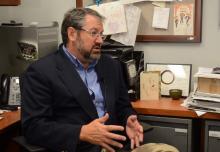NEW YORK – Sitting amid assorted curios scattered throughout the windowless, paper-strewn office where for the past 2 decades he taught and conducted research at Columbia University and the New York State Psychiatric Institute, Joshua A. Gordon, MD, PhD, reflected on his next career move.
“I’m nervous. Excited. I am going in with an open mind,” said Dr. Gordon, who in mid-September became the new director of the National Institute of Mental Health.
Some are hoping such an “open mind” will result in a change of priorities from those favored by Dr. Gordon’s predecessor, Thomas Insel, MD.
“I’d like to say how welcome it is to have a new perspective at the helm of the NIMH,” said Roberto Lewis-Fernandez, MD, a Columbia University psychiatry professor, and director of the New York State Center of Excellence for Cultural Competence at the New York State Psychiatric Institute, both in New York City.
After 13 years as director, Dr. Insel left the NIMH at the end of 2015 to take a job with a former Google division now called Verily Life Sciences, an Alphabet company. A psychiatrist also trained as a neuroscientist, Dr. Insel often was a flash point over concerns that during his tenure – the longest in NIMH history – neuroscience eclipsed other important areas, such as patient support, basic clinical observation, and the biopsychosocial model of mental illness.
“There is absolutely nothing wrong with neuroscience research. It is entirely indispensable to the discovery of new treatments for mental illness,” said Dr. Lewis-Fernandez. “The critique is about the proportion of the portfolio that should be devoted to this work.”
Future vs. now
Emphasizing too much “gee whiz” science at the expense of research into psychosocial services has meant the NIMH has failed to fully use its immense power to address disparities in access to care, create strategies for cost-efficient, scalable interventions, and clarify best practices in sorely needed suicide prevention, according to an editorial written by Dr. Lewis-Fernandez and 19 other current and former members of the NIMH National Advisory Mental Health Council (Br J Psychiatry. Jun 2016;208[6]507-9). In the piece, the writers took issue with what they called the NIMH’s overemphasis on basic and translational neuroscience research, citing how since 2012, the institute has spent less than 15% of its roughly $1.5 billion annual budget on non-HIV/AIDS services and interventions.
Dr. Insel often responded to such criticism in his widely read blog, where he acknowledged the tension between meeting patients’ current needs and investing in future discoveries, but also said the gap between what is known about the brain and about mental illness versus what is unknown was “unconscionable.” In an effort to help right this wrong, Dr. Insel announced that the NIMH essentially would drop use of the Diagnostic and Statistical Manual of Mental Disorders in favor of the Research Domain Criteria (RDoC) project, a new classification system of mental illness incorporating genetics, imaging, cognitive science, and other fields. He also made frequent media appearances to explain the institute’s participation in the 20-year, cross-disciplinary $4.5 billion Brain Research Through Advancing Innovative Neurotechnologies (BRAIN) Initiative. In addition, he championed the Human Connectome Project to map neurocircuitry.
‘Return to its roots’
Others believe that neuroscience notwithstanding, the institution, founded in 1949, is not hewing to its intended purpose, which is to “transform the understanding and treatment of mental illnesses through basic and clinical research, paving the way for prevention, recovery, and cure,” according to its mission statement.
“The NIMH needs to return to its roots: studying, taking care of, and hopefully curing seriously mentally ill patients. That should be the most important piece of its agenda,” said practicing psychiatrist David Pickar, MD. Between 1977 and 1999, Dr. Pickar held a variety of NIMH intramural research division posts, including section chief for clinical neuroscience studies and chief of experimental therapeutics. Currently, he is an adjunct professor of psychiatry at Johns Hopkins University, Baltimore.
Dr. Gordon said such clinical research can be achieved through grants to external investigators. “We have limited resources at the NIMH when you consider how much money is spent overall on mental health care,” Dr. Gordon said. Four NIMH divisions are dedicated to overseeing extramural research, compared with one intramural research division.
In a breakdown of NIMH spending between 2005 and 2014, Dr. Insel wrote that, when adjusted for biomedical inflation, the institute’s overall budget remained virtually flat since 2003. And while the scientific scope of grants funded has not changed much, “from molecular neuroscience to strategies of community care,” what has changed is the proportion of spending on certain areas as “scientific opportunities have evolved,” Dr. Insel wrote.


